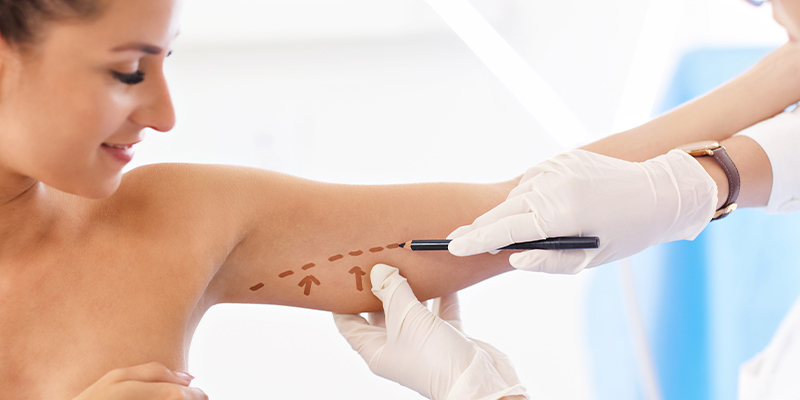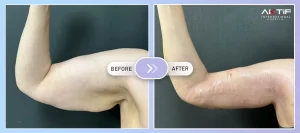
Estimated reading time: 7 minutes and 31 seconds
Arm Lift: A Comprehensive Guide
The appearance of the arms completes the appearance of the body as a whole. If there is sagging in the arms, the person may often hesitate to wear sleeveless clothes and participate in physical activities that draw attention to the arms. In such cases, arm lift surgery may be an option. In this article, we will examine everything you need to know about arm lift surgery, including types of arm lift surgery, arm lift surgery process, eligibility criteria, benefits, risks, preparation and recovery.

Arm Lift
Types of Arm Lift (Brachioplasty) Surgery
Arm lift surgery, also known as brachioplasty, is a cosmetic surgery that targets excess skin and fat in the upper arm area. There are different types of brachioplasty, including traditional arm lift surgery, minimal-incision arm lift surgery, extended arm lift surgery, and liposuction.
Traditional Brachioplasty: This type of surgery involves a long incision along the underside of the arm, from the armpit to the elbow. The surgeon removes excess skin and fat and tightens the underlying tissue. This surgery is suitable for patients with significant sagging skin and excess fat in the upper arm area.
Minimal-Incision Arm Lift Surgery: This type of surgery involves small incisions in the armpit or the back of the arm. The surgeon removes a smaller amount of skin and fat and tightens the underlying tissue. This surgery is suitable for patients with mild to moderate sagging skin and excess fat in the upper arm area.
Extended Brachioplasty: This type of surgery involves a longer incision that extends from the armpit to the chest. The surgeon removes excess skin and fat not only from the upper arm but also from the chest and armpit area. This surgery is suitable for patients with significant sagging skin and excess fat not only in the upper arm area but also in the chest and armpit area.
Liposuction: This type of surgery involves the removal of excess fat from the upper arm area using a suction device. This surgery is suitable for patients with excess fat in the upper arm area but with good skin elasticity.
The Arm Lift Surgery Process
Brachioplasty surgery process involves several steps, including consultation with the surgeon, pre-operative instructions, anesthesia, incision and tissue removal, and closing the incisions.
Consultation with the surgeon: Before the surgery, you will meet with the surgeon to discuss your goals, medical history, and eligibility for the surgery. The surgeon will examine your arms, take measurements, and explain the procedure and the potential risks and complications.
Pre-operative instructions: The surgeon will provide you with pre-operative instructions, such as avoiding certain medications, stopping smoking, and maintaining a healthy diet and lifestyle.
Anesthesia: Anesthesia to ensure that you are comfortable and pain-free.
Incision and tissue removal: The surgeon will make the appropriate incisions based on the type of surgery and remove excess skin and fat from the upper arm area.
Closing the incisions: The surgeon will close the incisions with sutures and apply dressings and compression garments.
Preparation for Brachioplasty
Preparing for brachioplasty involves several steps, such as following the pre-operative instructions provided by the surgeon, arranging for a ride home after the surgery, and preparing your home for recovery.
- Pre-operative instructions: You will need to follow the surgeon’s pre-operative instructions, such as avoiding certain medications, quitting smoking, and staying hydrated.
- Arranging for a ride home: Since you will be given anesthesia, you will need to arrange for someone to drive you home after the surgery.
- Preparing your home for recovery: You will need to prepare your home for recovery by stocking up on healthy foods, arranging for someone to help you with household chores, and creating a comfortable recovery area with pillows and blankets.
Recovery Process
Full recovery time is not the same for everyone. Recovery time may vary according to our health condition, the scope of the surgery and the techniques applied by the surgeon. Generally speaking, the recovery time after surgery will be approximately as follows:
First Days: Immediately after the operation, there may be swelling, bruising and pain in the operation area. This is normal and usually begins to decrease within a few days. We can get through this process more comfortably by using painkillers recommended by our doctor for pain.
Drains: In some cases, drains are placed to remove excess fluid and blood. These drains are usually removed after a few days.
Bandage and Wrap: After the operation, the arm area may be wrapped with bandages or bandages. These dressings are necessary to support postoperative shaping and reduce oedema formation.
Movement Restriction: It is recommended not to move the arms too much during the first few days. Moving the arms too much or lifting them upwards may strain the stitches and negatively affect the healing process. However, this does not mean that the arms should not be moved at all. Small movements can speed up blood circulation and have a positive effect on the healing process.
Stitches: If self-dissolving aesthetic sutures are not used, the sutures are usually removed after 1-2 weeks. If aesthetic stitches were used, the stitches do not need to be removed separately.
Return to Activity: Light activities can be started a few days after surgery. However, heavy physical activities and lifting movements should be avoided for another 4-6 weeks.
Scars: Surgical scars fade over time, but may not disappear completely. Sun protection and scar healing creams can be recommended to make the scars as less visible as possible. In addition, not smoking during the healing process will accelerate the healing process of our wounds and will contribute to less scars.
Seeing the Results: In order to see the full results, the swelling must completely subside. This may take several months after surgery.
After arm lift surgery, it is important to follow all the recommendations and instructions of our doctor. This both accelerates our healing process and reduces the risk of possible complications. If we experience any unusual symptoms or complications after the surgery, we should definitely consult our doctor.
Arm Lift Surgery at Aktif International Hospital
If you are considering brachioplasty, Aktif International Hospital offers state-of-the-art facilities, experienced surgeons, and personalized care to ensure a safe and successful outcome. Our team of experts will guide you through every step of the process, from consultation to recovery, to ensure that you achieve your desired results.

Arm Lift
Frequently Asked Questions
How long does arm lift surgery take?
The duration of arm lift surgery can vary depending on the extent of the surgery, but it usually takes around 2-3 hours.
What type of anesthesia is used for brachioplasty?
Brachioplasties at Aktif International are typically performed under general anesthesia. This ensures that you are completely asleep and comfortable throughout the procedure. Our experienced team of anesthesiologists will closely monitor you during the surgery to ensure your safety and well-being.
How long does it take to recover from arm lift surgery?
6 weeks. Recovery from arm lift surgery can take several weeks, and you may need to take a week off from work.
Will there be visible scarring after brachioplasty?
Yes. However, the scars are usually well-hidden and fade over time.
Can I undergo arm lift surgery if I am overweight?
Brachioplasty is typically recommended for patients who are at a healthy weight and have excess skin and fat on their upper arms. If you are overweight, your surgeon may recommend weight loss before undergoing the procedure.
Will brachioplasty help me lose weight?
Brachioplasty is not a weight loss procedure. Its purpose is to remove excess skin and fat from the upper arms to improve their appearance.
Can I undergo brachioplasty if I have a history of medical conditions?
Your eligibility for brachioplasty will depend on your medical history and current health.
When can I get back to work after arm lift surgery?
Most patients can return to work within a week of arm lift surgery, but this can vary depending on the extent of the surgery and the type of work you do.
How long do the results of brachioplasty last?
The results of brachioplasty are long-lasting, but they can be affected by factors such as aging, weight fluctuations, and lifestyle habits. Maintaining a healthy lifestyle can help prolong the results of the procedure.
Author: Erkan Kural
For more information about this surgery, please visit the websites of our doctors listed below:


 TR
TR